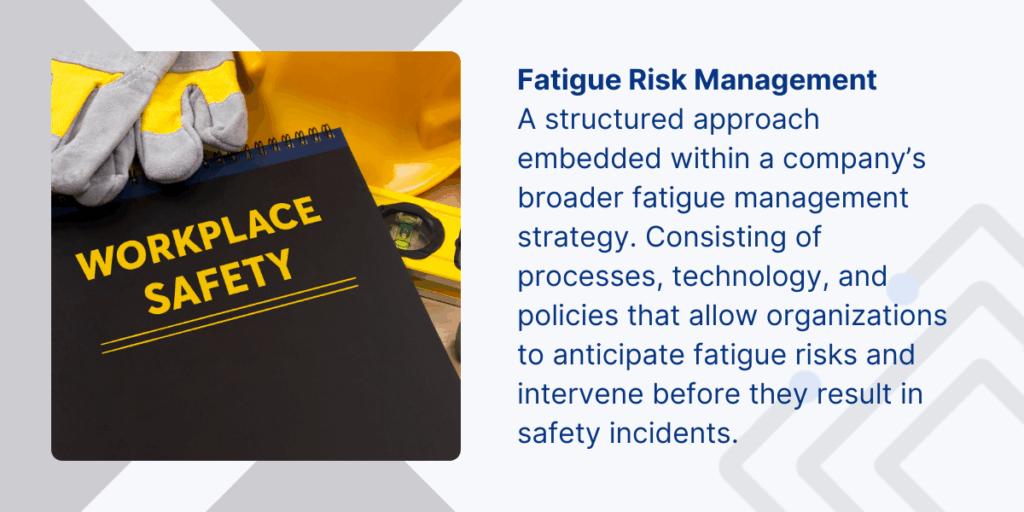In industries that operate around the clock—such as manufacturing, healthcare, energy, and transportation—employee fatigue is an ever-present risk. With long shifts, overnight coverage, and rotating schedules, the demand on workers can quickly exceed what is safe or sustainable. For these organizations, fatigue isn’t a productivity issue; it’s a safety hazard that can lead to costly incidents and regulatory consequences.
That’s why fatigue must be a core component of any robust risk management system—proactively identifying, assessing, and mitigating workplace hazards before incidents occur. Rather than responding to accidents after they occur, a fatigue risk management system empowers employers to prevent them by monitoring workload, enforcing rest periods, and scheduling smarter.
Understanding the Risk: Fatigue in 24/7 Environments
Fatigue is more than just being tired. It is a physiological condition that reduces alertness, impairs cognitive function, and slows reaction time; three qualities that are absolutely critical in high-risk environments. Workers operating machinery, transporting goods, or responding to emergencies cannot afford to be even slightly compromised by sleep deprivation or mental exhaustion.
The nature of 24/7 operations exacerbates these risks. Night shifts disrupt circadian rhythms, while rotating or unpredictable schedules prevent workers from establishing consistent rest routines. Over time, this leads to chronic fatigue, which not only undermines job performance but also increases the likelihood of human error. The National Safety Council reports that a worker who has been awake for 20+ hours is as impaired as someone with a blood alcohol concentration of 0.08%.
Fatigue also impacts long-term health. Employees subjected to constant sleep debt are at higher risk of cardiovascular disease, metabolic disorders, and depression. This leads to increased healthcare costs and higher turnover—two issues that strain the bottom line. Organizations that don’t actively manage fatigue expose themselves to both operational disruptions and serious legal liability.
What Is a Fatigue Risk Management System?
A fatigue risk management system is a structured approach embedded within a company’s broader fatigue management strategy. It consists of processes, technology, and policies that allow organizations to anticipate fatigue risks and intervene before they result in safety incidents. Key components include:
- Predictive Scheduling: Utilizing historical data, labor rules, and analytics to forecast fatigue risk across shifts and adjust schedules accordingly.
- Real-Time Monitoring: Implementing systems to detect signs of fatigue during operations. These systems provide alerts when workers are approaching unsafe limits and recommend corrective action, such as reassignments or mandatory rest periods.
- Incident Reporting: Tracking fatigue-related issues over time allows organizations to identify trends, determine root causes, and adjust their workforce strategy accordingly.
- Training and Education: Providing employees to recognize the signs of fatigue, report concerns without fear of retaliation, and understand the rationale behind scheduling decisions.
Unlike traditional compliance-based approaches that focus solely on work-hour limits, a fatigue risk management system offers a proactive and comprehensive strategy to enhance safety and performance.

Operational & Compliance Benefits
The intersection of workforce well-being, safety, and regulatory adherence is a delicate balance. A fatigue risk management system serves as a proactive tool to help maintain that balance—ensuring that employees are fit for duty while operations remain smooth, cost-effective, and legally compliant. By integrating fatigue controls into the broader risk management system, organizations can reduce exposure to incidents, improve labor efficiency, and build a culture of accountability and care.
Safety & Compliance
A comprehensive risk management system plays a critical role in maintaining a safe and compliant workplace, especially in high-stakes industries with continuous operations. When fatigue is proactively managed, the risk of workplace incidents and human error is significantly reduced. This is particularly important in roles involving heavy machinery, complex decision-making, or life-critical services, where even minor lapses in attention can have severe consequences.
Beyond safety, implementing fatigue controls helps ensure adherence to regulatory requirements. Agencies like the Nuclear Regulatory Commission (NRC) and the Occupational Safety and Health Administration (OSHA) mandate work-hour limits, rest periods, and other fatigue mitigation strategies in specific industries. A fatigue risk management system helps organizations demonstrate due diligence through automated compliance enforcement and robust documentation—mitigating the risk of costly violations or audit findings.
Operational Efficiency & Cost Control
Managing fatigue isn’t just about compliance—it’s also about optimizing performance. Well-rested employees are more productive, make better decisions, and complete tasks more efficiently. Fatigue management systems contribute to workforce reliability by reducing absenteeism, minimizing unplanned downtime, and supporting consistent operational output across shifts.
Cost savings are another significant benefit. Fatigue-related incidents often lead to increased insurance claims, workers’ compensation cases, and equipment damage. By reducing the likelihood of these events, organizations can lower their overall risk exposure. Additionally, smarter scheduling helps control overtime expenses and reduces the administrative burden on managers. Together, these operational improvements free up resources and strengthen the bottom line.
Real-World Impact
One of the clearest examples of fatigue risk management success comes from Xcel Energy, a leading U.S.-based nuclear energy provider. Operating in a highly regulated industry, Xcel Energy struggled with manual scheduling processes that made it difficult to track fatigue-related compliance requirements under NRC’s 10 CFR Part 26.
With Indeavor, Xcel Energy transitioned to an automated solution that enabled precise schedule generation and streamlined compliance tracking. By implementing Indeavor’s automated scheduling system, Xcel Energy achieved significant improvements:
- Reduced Scheduling Time: Automated tracking of complex fatigue rules eliminated the need for manual calculations, saving time.
- Enhanced Compliance: Automation checks ensured adherence to NRC regulations, reducing the risk of costly fines and safety incidents.
- Effortless Reporting: The system generated necessary reports for the NRC, saving staff time and resources.
- Improved Safety Culture: Proactive fatigue management through scheduling promoted a safer work environment.
The result was transformative. “It has become a one-stop shop by streamlining internal workflows and combining different processes and applications,” said John Truong, IT Manager-Nuclear at Xcel Energy. “This has resulted in a lot of time saved across multiple work groups.” Xcel’s experience highlights the operational and safety value of embedding fatigue risk management into a broader workforce risk management system.

How Indeavor Supports Fatigue Risk Management
Indeavor’s workforce management platform is designed specifically to meet the needs of 24/7 operations where fatigue risk is a daily concern. By integrating intelligent scheduling and real-time compliance checks into a single, user-friendly system, Indeavor helps organizations enforce fatigue management policies without compromising on operational efficiency.
Through automated scheduling, the platform creates shift plans that account for rest requirements, maximum work hours, and fatigue models tailored to each organization. This removes the guesswork from shift planning and ensures that managers don’t inadvertently assign workers beyond safe limits.
Indeavor also provides real-time operational visibility. Dashboards alert managers when employees are approaching fatigue thresholds or violating compliance rules. These insights allow for faster, smarter decisions—like calling in a rested backup or redistributing workload—before problems escalate.
Additionally, Indeavor simplifies regulatory compliance by automating documentation and reporting. Rather than manually tracking labor rules and generating reports, organizations can rely on the system to handle recordkeeping, flag noncompliance, and demonstrate due diligence during audits.
By empowering both workers and managers with mobile access to schedules and fatigue alerts, Indeavor’s platform transforms fatigue management from a reactive process into a proactive part of everyday operations.
Conclusion
24/7 operations carry a unique set of risks—and fatigue is one of the most pressing among them. A comprehensive fatigue risk management system is not just about staying compliant; it’s about protecting workers, maintaining operational continuity, and building a resilient, future-ready workforce.
Indeavor helps organizations transform how they manage risk by embedding fatigue controls directly into workforce scheduling and labor management. The result is safer, more efficient operations where compliance and care go hand-in-hand.
Ready to upgrade your risk management system? Schedule a demo today to learn how Indeavor can help you proactively manage fatigue and protect your most valuable asset—your people.
About the Author
Claire Pieper is the Digital Marketing Specialist for Indeavor. In her role, she specializes in crafting strategic and engaging content, ensuring that customers are well-informed. Claire is dedicated to enhancing the customer experience and optimizing the user journey through Indeavor’s solutions. To learn more or get in touch, connect with Claire on LinkedIn.



